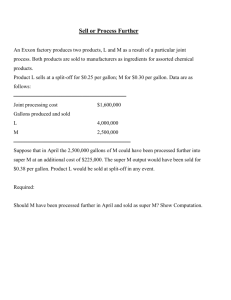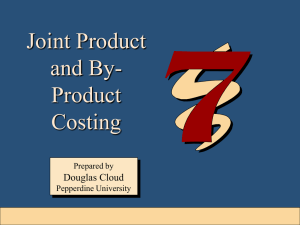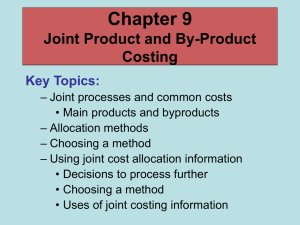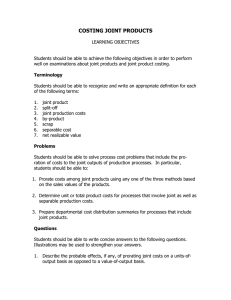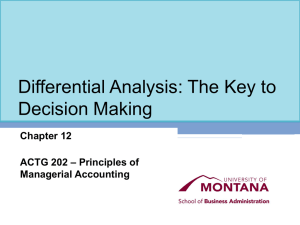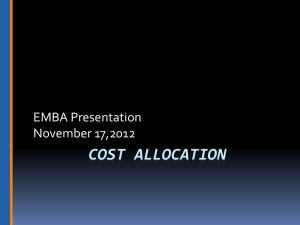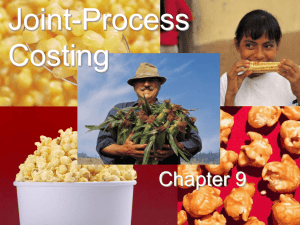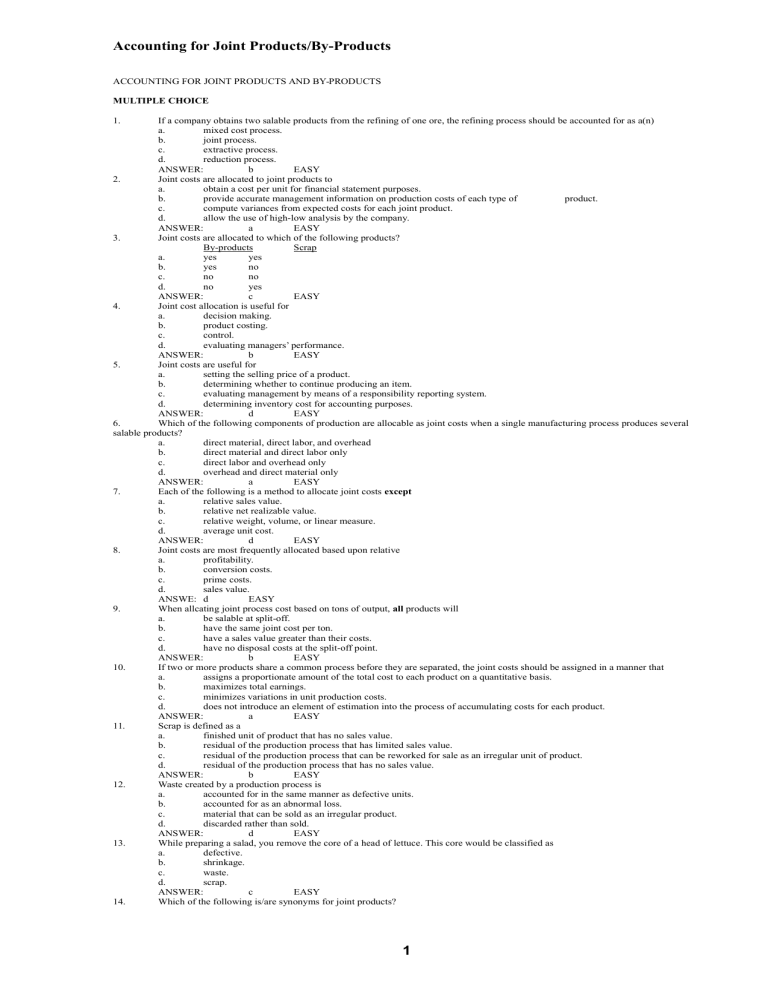
Accounting for Joint Products/By-Products ACCOUNTING FOR JOINT PRODUCTS AND BY-PRODUCTS MULTIPLE CHOICE 1. If a company obtains two salable products from the refining of one ore, the refining process should be accounted for as a(n) a. mixed cost process. b. joint process. c. extractive process. d. reduction process. ANSWER: b EASY 2. Joint costs are allocated to joint products to a. obtain a cost per unit for financial statement purposes. b. provide accurate management information on production costs of each type of product. c. compute variances from expected costs for each joint product. d. allow the use of high-low analysis by the company. ANSWER: a EASY 3. Joint costs are allocated to which of the following products? By-products Scrap a. yes yes b. yes no c. no no d. no yes ANSWER: c EASY 4. Joint cost allocation is useful for a. decision making. b. product costing. c. control. d. evaluating managers’ performance. ANSWER: b EASY 5. Joint costs are useful for a. setting the selling price of a product. b. determining whether to continue producing an item. c. evaluating management by means of a responsibility reporting system. d. determining inventory cost for accounting purposes. ANSWER: d EASY 6. Which of the following components of production are allocable as joint costs when a single manufacturing process produces several salable products? a. direct material, direct labor, and overhead b. direct material and direct labor only c. direct labor and overhead only d. overhead and direct material only ANSWER: a EASY 7. Each of the following is a method to allocate joint costs except a. relative sales value. b. relative net realizable value. c. relative weight, volume, or linear measure. d. average unit cost. ANSWER: d EASY 8. Joint costs are most frequently allocated based upon relative a. profitability. b. conversion costs. c. prime costs. d. sales value. ANSWE: d EASY 9. When allcating joint process cost based on tons of output, all products will a. be salable at split-off. b. have the same joint cost per ton. c. have a sales value greater than their costs. d. have no disposal costs at the split-off point. ANSWER: b EASY 10. If two or more products share a common process before they are separated, the joint costs should be assigned in a manner that a. assigns a proportionate amount of the total cost to each product on a quantitative basis. b. maximizes total earnings. c. minimizes variations in unit production costs. d. does not introduce an element of estimation into the process of accumulating costs for each product. ANSWER: a EASY 11. Scrap is defined as a a. finished unit of product that has no sales value. b. residual of the production process that has limited sales value. c. residual of the production process that can be reworked for sale as an irregular unit of product. d. residual of the production process that has no sales value. ANSWER: b EASY 12. Waste created by a production process is a. accounted for in the same manner as defective units. b. accounted for as an abnormal loss. c. material that can be sold as an irregular product. d. discarded rather than sold. ANSWER: d EASY 13. While preparing a salad, you remove the core of a head of lettuce. This core would be classified as a. defective. b. shrinkage. c. waste. d. scrap. ANSWER: c EASY 14. Which of the following is/are synonyms for joint products? 1 Accounting for Joint Products/By-Products Main products Co-products a. no no b. yes yes c. yes no d. no yes ANSWER: b EASY 15. In a lumber mill, which of the following would most likely be considered a primary product? a. 2 × 4 studs b. sawdust c. wood chips d. tree bark ANSWER: a EASY 16. Company Q produces three products from a joint process. The products can be sold at split-off or processed further. In deciding whether to sell at split-off or process further, management should a. allocate the joint cost to the products based on relative sales value prior to making the decision. b. allocate the joint cost to the products based on a physical quantity measure prior to making the decision. c. subtract the joint cost from the total sales value of the products before determining relative sales value and making the decision. d. ignore the joint cost in making the decision. ANSWER: d EASY 17. By-products are a. allocated a portion of joint production cost. b. not sufficient alone, in terms of sales value, for management to justify undertaking the joint process. c. also known as scrap. d. the primary reason management undertook the production process. ANSWER: b EASY 18. Which of the following statements is true regarding by-products or scrap? a. Process costing is the only method that should result in by-products or scrap. b. Job order costing systems will never have by-products or scrap. c. Job order costing systems may have instances where by-products or scrap result from the production process. d. Process costing will never have by-products or scrap from the production process. ANSWER: c MEDIUM 19. Which of the following has sales value? By-products Waste a. no no b. yes no c. yes yes d. no yes ANSWER: b EASY 20. Under an acceptable method of costing by-products, inventory costs of the by-product are based on the portion of the joint production cost allocated to the by-product a. but any subsequent processing cost is debited to the cost of the main product. b. but any subsequent processing cost is debited to revenue of the main product. c. plus any subsequent processing cost. d. minus any subsequent processing cost. ANSWER: c EASY 21. Which of the following is a false statement about scrap and by-products? a. Both by-products and scrap are salable. b. A by-product has a higher sales value than does scrap. c. By-products and scrap are the primary reason that management undertakes the joint process. d. Both scrap and by-products are incidental outputs to the joint process. ANSWER: c EASY 22. The split-off point is the point at which a. output is first identifiable as individual products. b. joint costs are allocated to joint products. c. some products may first be sold. d. all of the above. ANSWER: d EASY 23. A product may be processed beyond the split-off point if management believes that a. its marketability will be enhanced. b. the incremental cost of further processing will be less than the incremental revenue of further processing. c. the joint cost assigned to it is not already greater than its prospective selling price. d. both a and b. ANSWER: d EASY 24. Which of the following would not be considered a sunk cost? a. direct material cost b. direct labor cost c. joint cost d. building cost ANSWER: d EASY 25. The definition of a sunk cost is a. a cost that cannot be recovered regardless of what happens. b. a cost that relates to money poured into the ground. c. considered the original cost of an item. d. also known as an opportunity cost. ANSWER: a EASY 26. The net realizable value approach mandates that the NRV of the by-products/scrap be treated as a. an increase in joint costs. b. a sunk cost. c. a reduction of joint costs. d. a cost that can be ignored totally. ANSWER: c EASY 27. The netrelizable value approach is normally used when the NRV is expected to be insignificant a. yes significant yes b. c. 2 no no yes no Accounting for Joint Products/By-Products d. yes no 3 ANSWER: b EASY 28. Approximated net realizable value at split-off for joint products is computed as a. selling price at split-off minus further processing and disposal costs. b. final selling price minus further processing and disposal costs. c. selling price at split-off minus allocated joint processing costs. d. final selling price minus a normal profit margin. ANSWER: b EASY 29. Which of the following is a commonly used joint cost allocation method? a. high-low method b. regression analysis c. approximated sales value at split-off method d. weighted average quantity technique ANSWER: c EASY 30. Incremental separate costs are defined as all costs incurred between ___________ and the point of sale. a. inception b. split-off point c. transfer to finished goods inventory d. point of addition of disposal costs ANSWER: b EASY 31. All costs that are incurred between the split-off point and the point of sale are known as a. sunk costs. b. incremental separate costs. c. joint cost. d. committed costs. ANSWER: b EASY 32. Incremental revenues and costs need to be considered when using which allocation method? Physical measures Sales value at split-off a. yes yes b. yes no c. no no d. no yes ANSWER: c MEDIUM 33. The method of pricing by-products/scrap where no value is assigned to these items until they are sold is known as the a. net realizable value at split-off point method. b. sales value at split-off method. c. realized value approach. d. approximated net realizable value at split-off method. ANSWER: c MEDIUM 34. Relative sales value at split-off is used to allocate costs beyond split-off joint costs a. yes yes b. yes no c. no yes d. no no ANSWER: c EASY 35. For purposes of allocating joint costs to joint products using the relative sales value at split-off method, the costs beyond split-off a. are allocated in the same manner as the joint costs. b. are deducted from the relative sales value at split-off. c. are deducted from the sales value at the point of sale. d. do not affect the allocation of the joint costs. ANSWER: d EASY 36. Not-for-profit organizations are required by the _______ to allocate joint costs. a. AICPA b. FASB c. CASB d. GASB ANSWER: a DIFFICULT Use the following information for questions 37–45. Crop Co. produces two products from a joint process: X and Z. Joint processing costs for this production cycle are P8,000. X Z Yards 1,500 2,200 Disposal Sales price cost per per yard at yard at split-off split-off P6.00 P3.50 9.00 5.00 Further Final sale processing price per per yard yard P1.00 P 7.50 3.00 11.25 If X and Z are processed further, no disposal costs will be incurred or such costs will be borne by the buyer. 37. Using a physical measure, what amount of joint processing cost is allocated to X (round to the nearest peso)? a. P4,000 b. P4,757 c. P5,500 d. P3,243 ANSWER: d EASY 38. Using a physical measure, what amount of joint processing cost is allocated to Z (round to the nearest peso)? a. P4,000 b. P3,243 c. P5,500 d. P4,757 ANSWER: d EASY 39. Using sales value at split-off, what amount of joint processing cost is allocated to X (round to the nearest peso)? a. P5,500 b. c. d. P2,500 P4,000 P3,243 ANSWER: b MEDIUM 40. Using sales value at split-off, what amount of joint processing cost is allocated to Z (round to the nearest peso)? a. P5,500 b. P4,000 c. P2,500 d. P4,757 ANSWER: a MEDIUM 41. Using net realizable value at split-off, what amount of joint processing cost is allocated to X (round to the nearest peso)? a. P4,000 b. P5,610 c. P2,390 d. P5,500 ANSWER: c MEDIUM 42. Using net realizable value at split-off, what amount of joint processing cost is allocated to Z (round to the nearest peso)? a. P5,500 b. P4,000 c. P2,390 d. P5,610 ANSWER: d MEDIUM 43. Using approximated net realizable value at split-off, what amount of joint processing cost is allocated to X (round to the nearest peso)? a. P3,090 b. P5,204 c. P4,000 d. P2,390 ANSWER: a MEDIUM 44. Using approximated net realizable value at split-off, what amount of joint processing cost is allocated to Z (round to the nearest peso)? a. P2,796 b. P4,910 c. P4,000 d. P2,390 ANSWER: b MEDIU 45. Which products would be processed further? a. only X b. only Z c. both X and Z d. neither X or Z ANSWER: a MEDIUM Use the following information for questions 46–51. Tiny Co. produces three products: Bo, Mo, and Lo from the same process. Joint costs for this production run are P2,100. Disposal Sales price cost per Further Final per lb. at lb. at processing sales price Pounds split-off split-off per pound per pound Bo 800 P6.50 P 3.00 P2.00 P 7.50 Mo 1,100 8.25 4.20 3.00 10.00 Lo 1,500 8.00 4.00 3.50 10.50 If the products are processed further, Tiny Co. will incur the following disposal costs upon sale: Bo, P3.00; Mo, P2.00; and Lo, P1.00. 46. Using a physical measurement method, what amount of joint processing cost is allocated to Bo (round to the nearest peso)? a. P700 b. P679 c. P927 d. P494 ANSWER: d EASY47. Using a physical measurement method, what amount of joint processing cost is allocated to Mo (round to the nearest peso)? a. P494 b. P679 c. P927 d. P700 ANSWER: b EASY 48. Using sales value at split-off, what amount of joint processing cost is allocated to Mo (round to the nearest peso)? a. P700 b. P416 c. P725 d. P959 ANSWER: c MEDIUM 49. Using sales value at split-off, what amount of joint processing cost is allocated to Lo (round to the nearest peso)? a. P959 b. P725 c. P700 d. P416 ANSWER: a MEDIUM 50. Using net realizable value at split-off, what amount of joint processing cost is allocated to Bo (round to the nearest peso)? a. P706 b. P951 c. P700 d. P444 ANSWER: d MEDIUM 51. Using net realizable value at split-off, what amount of joint processing cost is allocated to Lo (round to the nearest peso)? a. P706 b. P951 c. P444 d. P700 ANSWER: b MEDIUM Use the following information for questions 52 and 53. DED Co. is placing an ad in the local paper to advertise its products. The ad will run for one week at a total cost of P5,500. DED has four categories of products as follows: % of floor space Expected sales occupied value Hardware 20% P35,000 Hand Tools 15 15,000 Lawn Furniture 45 64,500 Light Fixtures 20 25,500 52. What amount of advertising cost should be allocated to hardware, assuming DED allocates based on percent of floor space occupied? a. P1,375 b. P1,100 c. P2,475 d. P 825 ANSWER: b EASY 53. Assume that DED decides to allocate based on expected sales value. What amount of advertising cost should be allocated to light fixtures (round to the nearest peso)? a. P1,375 b. P589 c. P1,002 d. P2,534 ANSWER: c MEDIUM Use the following information for questions 54–59. Rax produces four products from the same process: Cep, Dap, Eek, and Gok. Joint product costs are P9,000. (Round all answers to the nearest peso.) Cep Dap Eek Gok Barrels 750 1,000 1,400 2,000 Disposal Sales price cost per barrel per barrel at split-off at split-off P10.00 P6.50 8.00 4.00 11.00 7.00 15.00 9.50 Final Further sales processing price costs per barrel P2.00 P13.50 2.50 10.00 4.00 15.50 4.50 19.50 If Rax sells the products after further processing, the following disposal costs will be incurred: Cep, P2.50; Dap, P1.00; Eek, P3.50; Gok, P6.00. 54. Using a physical measurement method, what amount of joint processing cost is allocated to Dap? a. P1,748 b. P2,447 c. P1,311 d. P3,495 ANSWER: a MEDIUM 55. Using a physical measurement method, what amount of joint processing cost is allocated to Eek? a. P3,495 b. P2,447 c. P1,748 d. P1,311 ANSWER: b MEDIU 56. Using sales value at split-off, what amount of joint processing cost is allocated to Dap? a. P4,433 b. P2,276 c. P1,108 d. P1,182 ANSWER: d MEDIUM 57. Using sales value at split-off, what amount of joint processing cost is allocated to Gok? a. P4,433 b. P1,182 c. P1,108 d. P2,276 ANSWER: a MEDIUM 58. Using net realizable value at split-off, what amount of joint processing cost is allocated to Cep? a. P1,550 b. P1,017 c. P4,263 d. P2,170 ANSWER: b MEDIUM 59. Using net realizable value at split-off, what amount of joint processing cost is allocated to Eek? a. P1,017 b. P1,550 c. P2,170 d. P4,263 ANSWER: c MEDIUM Use the following information for questions 60–63. Sun Co. produces three products from the same process that has joint processing costs of P4,100. Products RR, SS, and TT are produced in the following gallons per month, respectively: 250, 400, and 750. Sun also incurred advertising costs of P60,000; the ad was used to run sales for all three products. They occupy floor space in the following ratio: 5:4:9. (Round all answers to the nearest peso.) 60. Using gallons as the physical measurement, what amount of joint processing cost is allocated to SS? a. P2,196 b. P1,171 c. P1,367 d. P732 ANSWER: b EASY 61. Using gallons as the physical measurement, what amount of joint processing cost is allocated to TT? a. P2,196 b. P732 c. P1,367 d. P1,171 ANSWER: a EASY 62. Assume that Sun chooses to allocate its advertising cost among the three products. What amount of advertising cost is allocated to RR using the floor space ratio? a. P20,000 b. P17,806 c. P1,139 d. P16,667 ANSWER: d EASY 63. Assume that Sun chooses to allocate its advertising cost among the three products. What amount of advertising cost is allocated to SS using the floor space ratio? a. P911 b. P14,244 c. P13,333 d. P20,000 ANSWER: c EASY 64. Love Co. manufactures products A and B from a joint process. Sales value at split-off was P700,000 for 10,000 units of A, and P300,000 for 15,000 units of B. Using the sales value at split-off approach, joint costs properly allocated to A were P140,000. Total joint costs were a. P98,000. b. P200,000. c. P233,333. d. P350,000. ANSWER: b EASY 65. Lite Co. manufactures products X and Y from a joint process that also yields a by-product, Z. Revenue from sales of Z is treated as a reduction of joint costs. Additional information is as follows: Units produced Joint costs ? Sales value at split-off X 20,000 ? Products Y 20,000 ? Z Total 10,000 50,000 P262,000 P300,000 P150,000 P10,000 P460,000 Joint costs were allocated using the sales value at split-off approach. The joint costs allocated to product X were a. P75,000. b. P100,800. c. P150,000. d. P168,000. ANSWER: d EASY SHORT ANSWER/PROBLEMS 1. Briefly discuss the four decisions that management must make concerning joint processes. ANSWER: The four decisions that managers must make regarding joint processes are as follows. They must try to determine what joint costs, selling costs, and separate processing costs are expected to occur when certain products are manufactured. Next, management must decide on the best use of resources that are available. Managers must next classify, as joint products and/or by-products/scrap, the output of production. The last decision that must be made is whether some or all of the products will be processed further or sold at split-off. This decision is made based on the incremental costs that would be incurred to process further and the incremental revenue if processed further. Joint production costs are irrelevant to this decision. MEDIUM 2. Briefly discuss the six steps in the allocation process. ANSWER: The six steps are as follows: 1. Choose the basis on which to allocate joint cost. 2. List all values that comprise the basis. 3. Add up all the values in the list (#2). 4. Determine the percentage of the total each item in #2 is. 5. Multiply the percentage by the cost being allocated. 6. For valuation purposes, divide the prorated cost by equivalent units of production. MEDIUM 3. Discuss briefly the three monetary measurement techniques of joint cost allocation. ANSWER: The sales value at split-off method assigns costs based only on the weighted proportions of the total sales values of the joint products without consideration of disposal costs at the split-off point. To use this method, all products must be salable at the split-off point. The net realizable value method assigns costs based on the product’s proportional net realizable value at the split-off point. Net realizable value is equal to product sales revenue at split-off minus any costs necessary to prepare and dispose of the product. Approximated net realizable value at split-off method requires that a simulated net realizable value at split-off be calculated. This is equal to final sales price minus incremental separate costs. Incremental separate costs refer to all costs that are incurred between split-off and the point of sale. MEDIUM 4. Briefly discuss the restrictions and requirements on service organizations and notfor-profits that relate to joint cost allocation. ANSWER: Service and not-for-profit organizations incur costs that may be considered joint in nature, such as advertising and printing of multipurpose documents. Service organizations are not required to allocate these costs to the items worked on, delivered, or advertised but may choose to do so for a better matching of revenues and expenses. Not-for-profits are required by the AICPA to allocate these costs among the activities of fundraising, accomplishing an organizational program, or conducting an administrative function. MEDIUM 5. Briefly discuss the net realizable value at split-off point method of allocating joint costs. ANSWER: The net realizable value at split-off method assigns joint costs based on each product’s proportional NRV at the split-off point. NRV is equal to sales price minus costs that are necessary to prepare and dispose of the product. To use this method, all products must be salable at the split-off point. MEDIUM 6. Why is the net realizable value of scrap used to lower estimated overhead costs in setting a predetermined overhead rate in a job order costing situation in which scrap is expected on most jobs? ANSWER: The net realizable value of scrap is used in this way because the amount received from the sale of scrap is considered to be a reduction of the total cost incurred in the production process. This process is similar to the treatment of sales values of assets purchased and then sold in a “basket” of goods. The estimated cost of scrap is used in setting overhead rates; therefore, when the scrap is sold the amount received should be a reduction of total overhead. MEDIUM Use the following information for questions 7 and 8. BL Company produces only two products and incurs joint processing costs that total P3,750. Products Aba and Ibi are produced in the following quantities during each month: 4,500 and 6,000 gallons, respectively. BL also runs one ad each month that advertises both products at a cost of P1,500. The selling price per gallon for the two products are P20 and P17.50, respectively. 7. What amount of joint processing costs is allocated to each product based on gallons produced? ANSWER: A = 4,500/10,500 × P3,750 = P1,607 I = 6,000/10,500 × P3,750 = P2,143 EASY 8. What amount of advertising cost is allocated to each product based on sales value? ANSWER: A = 4,500 × P20.00 = P 90,000/P195,000 × P1,500 = P692 I = 6,000 × P17.50 = 105,000/P195,000 × P1,500 = P808 P195,000 MEDIUM Use the following information for questions 9 and 10. GAB Company produces three products from the same process and incurs joint processing costs of P3,000. Mat Nat Qat Gallons 2,300 1,100 500 Disposal Sales price cost per per gallon gallon at at split-off split-off P 4.50 P1.25 6.00 3.00 10.00 8.00 Further Final sales processing price per costs gallon P1.00 P 7.00 2.00 10.00 2.00 15.00 Disposal costs for the products if they are processed further are: Mat, P3.00; Nat, P5.50; Qat, P1.00. 9. 10. What amount of joint processing cost is allocated to the three products using sales value at split-off? ANSWER: M = 2,300 × P 4.50 = P10,350/P21,950 × P3,000 = P1,415 N = 1,100 × P 6.00 = P 6,600 P21,950 × P3,000 = P902 Q = 500 × P10.00 = P 5,000/P21,950 × P3,000 = P683 P21,950 What amount of joint processing cost is allocated to the three products using net realizable value at split-off? ANSWER: Sales price minus disposal cost* P4.50 – P1.25 = P3.25 P6.00 – P3.00 = 3.00 P10.00 – P8.00 = 2.00 M = 2,300 × P 3.25* = P 7,475 /P11,775 × P3,000 = P1,904 N = 1,100 × P 3.00* =P 3,300 /P11,775 × P3,000 = P 841 Q = 500 × P 2.00* = P 1,000 /P11,775 × P3,000 = P 255 P11,775 11. A company produces two main products jointly, A and B, and C, which is a by-product of B. A and B are produced form the same raw material. C is manufactured from the residue of the process creating B. Costs before separation are apportioned between the two main products by the net realizable value method. The net revenue realized from the sale of C is deducted from the cost of B. Data for April were as follows: Costs bfore separationP 200,000 Costs after separation: A 50,000 B 32,000 C 4,000 Production for April, in pounds: A 800,000 B 200,000 C 20,000 Sales for April: A 640,000 pounds @ P.4375 B 180,000 pounds @ .65 C 20,000 pounds @ .30 Required: Determine the gross profit for April. ANSWER: NRV C REVENUE 20,000 × .30 = COST NRV P6,000 (4,000 ) P2,000 NRV: A B (800,000 × P.4375) = P350,000 – P50,000 = P300,000 (200,000 × P.65) = P130,000 – (P32,000 – P2,000) = 100,000 P400,000 ALLOCATION: A (P300,000/P400,000 × P200,000 = P150,000 B (P100,000/P400,000 × P200,000 = 50,000 UNIT COST: A (P150,000 + P50,000)/800,000 = P .25 B (P50,000 + P30,000)/200,000 = P .40 GROSS PROFIT: A (P .4375 – P.25) × 640,000 = P120,000 B (P .65 – P.40) × 180,000 = 45,000 P165,000 DIFFICULT 12. The total joint cost of producing 2,000 pounds of Product A; 1,000 pounds of Product B; and 1,000 pounds of Product C is P7,500. Selling price per pound of the three products are P15 for Product A; P10 for Product B; and P5 for Product C. Joint cost is allocated using the sales value method. Required: a. Compute the unit cost of Product A if all three products are main products. b. Compute the unit cost of Product A if Products A and B are main products and Product C is a by-product for which the cost reduction method is used. ANSWER: a. SALES VALUE A B C UNIT COST 2,000 × P15 = P30,000/P45,000 × P7,500 = P5,000/2,000 = P2.50 1,000 x P10 P10,000/P45,000 x P7,500 = P1,667/1,000 = P1.67 1,000 x P5 P 5,000/P45,000 x P7,500 = P 833/1,000 = P .83 P45,000 P7,500 b. TO ALLOCATE: P7,500 – P5,000 = P2,500 SALES VALUE UNIT COST A 2,000 × P15 = P30,000/P40,000 × P2,500 = P1,875/2,000 = P.9375 B 1,000 × P10 = P10,000/P40,000 × P2,500 = P 625/1,000 = P.625 P40,000 P2,500 13. A Manufacturing Company makes three products: A and B are considered main products and C a by-product. Production and sales for the year were: 220,000 lbs. of Product A, salable at P6.00 180,000 lbs. of Product B, salable at P3.00 50,000 lbs. of Product C, salable at P.90 Production costs for the year: Joint costs P276,600 Costs after separation: Product A 320,000 Product B 190,000 Product C 6,900 Required: Using the by-product revenue as a cost reduction and net realizable value method of assigning joint costs, compute unit costs (a) if C is a by-product of the process and (b) if C is a by-product of B. ANSWER: a. JOINT COST P276,600 – NRV C (38,100 ) (50,000 – P.90) – P6,900 TO ALLOCATE P238,500 SALES VALUE – COST AFTER SEPARATION = NRV 220,000 × P6 = P1,320,000 – P320,000 = P1,000,000 180,000 × P3 = P 540,000 – P190,000 = 350,000 P1,350,000 ALLOCATION P1,000,000/P1,350,000 × P238,500 = P 350,000/P1,350,000 × P238,500 = UNIT COST: A (P176,667 + P320,000)/220,000 = B (P61,833 + P190,000)/180,000 = b. NRV A B P176,667 61,833 P238,500 P2.26 P1.40 P1,000,000 = P1,000,000/P1,388,100 × P276,600 = P199,265 P350,000 + P38100 = 388,100/P1,388,100 × P276,600 = P 77,335 P1,388,100 UNIT COST A (P199,265 + P320,000)/220,000 = P2.36 B (P77,335 + P151,900)/180,000 = P1.27 MEDIUM 14. Smith Co. processes raw material in Department 1 from which come two main products, A and B, and a by-product, C. A is further processed in Department 2, B in Department 3, and C in Department 4. The value of the by-product reduces the cost of the main products, and sales value is used to allocate joint costs. Cost Incurred: Production: A B C Selling Price: A B C Dept 1 P90,000 Dept 2 P10,000 Dept 3 P8,000 Dept 4 P10,000 10,000 lbs. 20,000 lbs. 10,000 lbs. P10/lb. P5/lb. P2/lb. Required: a. Compute unit costs for A and B. b. Ending inventory consists of 5,000 lbs. of B and 1,000 lbs. of C. What is the value of the inventory? c. Recompute a and b allocating cost based on net realizable value. ANSWER: a. JOINT COST P90,000 – SALES VALUE (20,000 ) (10,000 × P2) P70,000 SALES VALUE A 10,000 × P10 = P100,000/P200,000 × P70,000 = P35,000 B 20,000 × P 5 = 100,000/P200,000 × P70,000 = P35,000 P200,000 UNIT COST A (P35,000 + P10,000)/10,000 = P4.50 B (P35,000 + P8,000)/20,000 = P2.15 b. ENDING INVENTORY B 5,000 × P2.15 = P10,750 C 1,000 × P2.00 = 2,000 P12,750 c. NRV A B P100,000 – P10,000 =P 90,000/P182,000 × P70,000 = P34,615 P100,000 – P8,000 = 92,000/P182,000 × P70,000 = 35,385 P182,000 P70,000 UNIT COST A (P34,615 + P10,000)/10,000 = P4.46 B (P35,385 + P8,000)/20,000 = P2.17 ENDING INVENTORY B 5,000 × P2.17 = C 1,000 × P2.00 = P12,850 P10,850 2,000 MEDIUM . Three identifiable product lines, Products A, B, and C, are obtained in fixed quantities from a basic processing operation. The cost of the basic operation is P320,000 for a yield of 5,000 tons of Product A; 2,000 tons of Product B; and 1,000 tons of Product C. The basic processing cost is allocated to the product lines in proportion to the relative weight produced. Beltway Products Company does both the basic processing work and the further refinement of the three product lines. After the basic operation, the products can be sold at the following prices per metric ton: Product A—P60 Product B—P53 Product C—P35 Costs to refine each of the three product lines follow: Product Lines A Variable cost per metric ton Total fixed cost P20,000 B P8 P16,000 C P7 P6,000 P4 The fixed cost of the refining operation will not be incurred if the product line is not refined. The refined products can be sold at the following prices per metric ton: Product A—P75 Product B—P65 Product C—P40 Required: a. Determine the total unit cost of each product line in a refined state. b. Which of the three product lines, if any, should be refined and which should be sold after the basic processing operation? Show computations. ANSWER: WT a. A B C 2,000 1,000 8,000 ALLOCATION 5,000 5,000/8,000 × P320,000 = P200,000 2,000/8,000 × P320,000 = 80,000 1,000/8,000 × P320,000 = 40,000 P320,000 UNIT COST A (P200,000 + P20,000)/5,000 + P8 = B (P80,000 + P16,000)/2,000 + P7 = C (P40000 + P6,000)/1,000 + P4 = P50 P52 P55 b. CHANGE IN REVENUE – CHANGE IN COST = CHANGE IN PROFIT A P75–P60 = P15 – (P20,000/5,000) + P8 = + P3 B P65–P53 = P12 – (P16,000/2,000) + P7 = – P3 C P40–P35 = P5 – (P6,000/1,000) + P4 = – P5 Therefore, process only Product A. 16. The Stone Company produced three joint products at a joint cost of P100,000. These products were processed further and sold as follows: Product A B C Sales P245,000 330,000 175,000 Additional Processing Costs P200,000 300,000 100,000 The company has had an opportunity to sell at split-off directly to other processors. If that alternative had been selected, sales would have been: A, P56,000; B, P28,000; and C, P56,000. The company expects to operate at the same level of production and sales in the forthcoming year. Required: Consider all the available information and assume that all costs incurred after split-off are variable. a. Could the company increase net income by altering its processing decisions? If so, what would be the expected overall net income? b. Which products should be processed further and which should be sold at split-off?ANSWER: a. Currently NI is Sales P750,000 Additional Processing Costs – JC (600,000 ) P150,000 (100,000 ) P 50,000 NI can be increased by P11,000 if A is not processed. b. EASY A Sales P189,000 – Cost (200,000 ) NI/(LOSS)P(11,000 ) B C P302,000 (300,000 ) P 2,000 P119,000 (100,000 ) P 19,000
